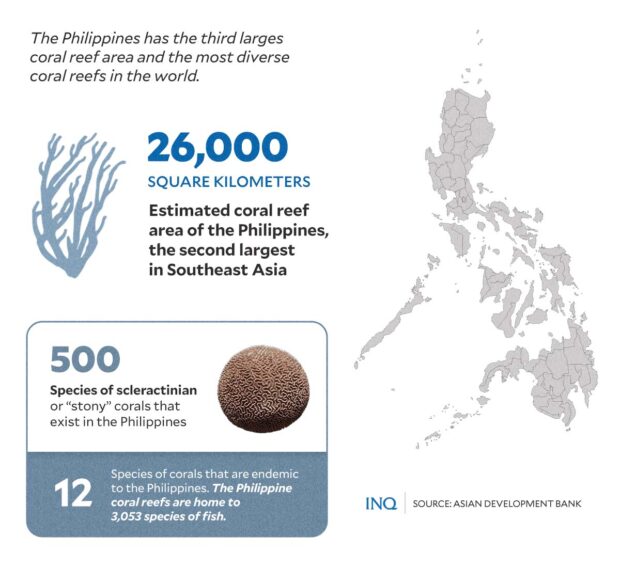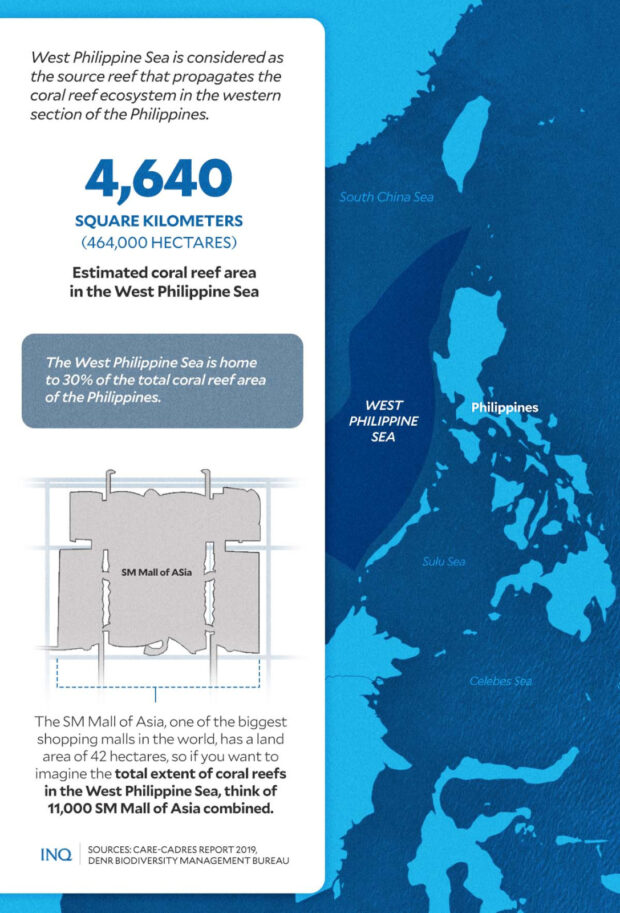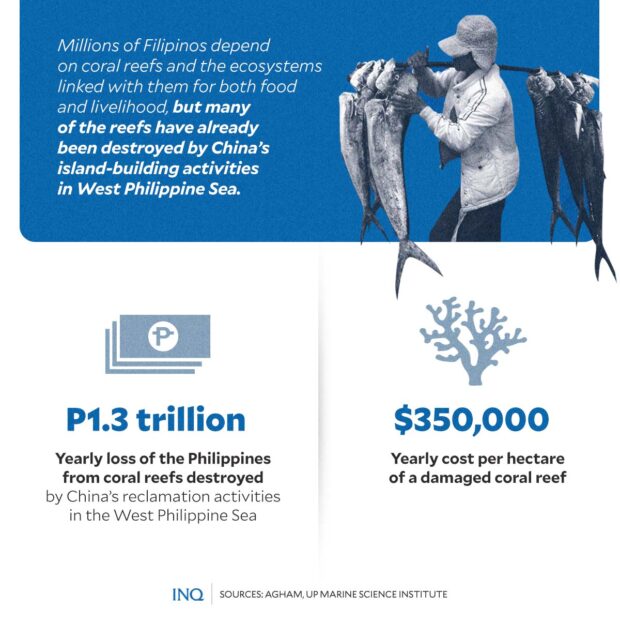Justice sought as China intrusion brings ‘immeasurable’ destruction to PH coral reefs

WPS FISHERMEN COMPOSITE IMAGE: JEROME CRISTOBAL / INQUIRER STOCK AND FILE PHOTOS
MANILA, Philippines—SM Mall of Asia (SM MoA), one of the biggest shopping malls in the world, is 42 hectares, so if you want to have an idea of the size of Philippine coral reefs in the West Philippine Sea, think of 11,000 SM MoAs.
According to data from the Asian Development Bank (ADB), the Philippines’ estimated coral reef area of 26,000 square kilometers is believed to be the third largest and most diverse in the world.
The Philippines, the ADB said, has 500 species of scleractinian or “stony” corals, which are home to 3,053 species of fish. Out of all the coral species, 12 are endemic to, or found only in, the Philippines.
According to the CARE-CaDRES Report 2019, the WPS, which has an estimated coral reef area of 4,640 square kilometers, is considered as the source reef that propagates the coral reef ecosystem in the western section of the Philippines.

GRAPHIC Ed Lustan
The US National Oceanic and Atmospheric Administration explained that as one of the most diverse ecosystems in the world, coral reefs are often referred to as the “rainforests of the sea.”
Article continues after this advertisementREAD: Tolentino wants int’l groups to help PH probe China’s alleged reef destruction in WPS
“[They] protect coastlines from storms and erosion, provide jobs for local communities, and offer opportunities for recreation. They are also a source of food and new medicines. Over half a billion people depend on reefs for food, income, and protection,” it said.
Article continues after this advertisement
GRAPHIC Ed Lustan
However, because of China’s illegal activities in the West Philippine Sea, which, the Permanent Court of Arbitration (PCA) said, is within the exclusive economic zone (EEZ) of the Philippines, close to 2,000 hectares of coral reefs had already been destroyed.
China is denying this.
READ: From intrusion to destruction
But the Philippines, as stated by the Department of Justice (DOJ), will not back down as it will proceed with the filing of charges against China over what it described as “innumerable and immeasurable” environmental damage.
Way to go
While the case will “irritate China as was before,” the initiation of the case is the way to go, said Joshua Bernard Espeña, a defense expert and international affairs academic.
He told INQUIRER.net via FB Messenger that the government’s decision to hold China to account is a “practical move to demonstrate the Philippines’ preference for upholding a rules-based international order.”
As stressed by Justice Secretary Jesus Crispin Remulla, the case is “on behalf not only of the Filipino people but the rest of humanity,” pointing out that it is expected to be ready for filing early next year. They are now organizing evidence, he said.
Looking back, it was on Sept. 18 when the Philippine Coast Guard (PCG) confirmed the “severe damage” to marine resources, especially coral reefs, in the seabed of Rozul (Iroquois) Reef and Escoda (Sabina) Shoal.
READ: Coast guard surveys ‘deliberate’ reef damage
The ecosystem there “appeared lifeless, with minimal to no signs of life,” said Commodore Jay Tarriela, PCG spokesperson for the West Philippine Sea. He pointed out that this confirmed earlier reports by the Armed Forces of the Philippines.
Both the Rozul Reef and Escoda Shoal have been swarmed by Chinese militia vessels.
This prompted Remulla to recommend the filing of a new case against China, consistent with what former Senior Associate Justice Antonio Carpio had said—that the Philippines should make China pay for the damage it has inflicted on resources in the WPS.
READ: PH should demand damages from China for destroying corals — Carpio
Trail of destruction
Back in 2018, Carpio said, too, that the Philippines should demand damage compensation from China for the destruction of coral reefs in Panatag (Scarborough) Shoal, especially since the National Security Council had confirmed that Chinese fishermen were the culprits.
As pointed out by Carpio, China violated its obligation in the United Nations Convention on the Law of the Sea “to protect and preserve the marine environment.”
READ: PH can sue China for WPS reef, coral damage — Carpio
Interestingly, when the PCA decided that China’s nine-dash line is baseless and illegal, it was stressed, too, that China “caused severe harm to the coral reef environment,” especially because of its large-scale land reclamation and construction of artificial islands for use as military bases.
Giant clams were dredged by the Chinese, too, causing the destruction of coral reefs.
Looking back, the Department of Foreign Affairs revealed in 2019 that it would take legal action against China for poaching giant clams and destroying fragile corals in Panatag Shoal.

GRAPHIC Ed Lustan
According to data from AGHAM (Advocates of Science and Technology for the People), the Philippines is losing P1.3 trillion a year because of coral reefs destroyed by China’s illegal activities in the WPS.
RELATED STORY: Remulla calls for int’l action vs China’s reef destruction in WPS
As pointed out by the Marine Science Institute of the University of the Philippines, if the destruction of the coral reefs persists, it may cost the Philippines $350,000 for every hectare yearly.
It said the losses would result from the lack of access to the benefits or services provided by coral reefs like food, climate regulation, and tourism.
‘No more appeasement’
With the filing of charges, Espeña pointed out that there is no doubt that the Marcos administration is “pivoting away from [Rodrigo] Duterte’s failed appeasement logic in foreign affairs.”
“By appeasement, we mean Filipinos toning down in rhetoric and action with the hope that China does the same,” said Espeña, a resident fellow of the think tank International Development and Security Cooperation.
The problem, however, is that China, like any rising power in world history, “has regional and global ambitions—that include solidifying its claim in the First Island Chain,” or the chain of islands encompassing Japan, Taiwan, parts of the Philippines, and Indonesia.
“So, understandably, no longer should we view the fight as within WPS alone; it also includes the Luzon Strait in preparation for a Taiwan contingency,” Espeña said.
He stressed that despite the filing of charges, “I have doubts whether Beijing would have any new moves to counter if not punish Manila’s actions.”
“For instance, economic sticks: Aquino III administration was not intimidated by Beijing’s discard of Filipino banana exports after Manila filed for arbitration [in 2013],” Espeña pointed out.
As for the Marcos presidency, he said the government already “made its initial move to cancel BRI (Belt and Road Initiative)-related railway projects to demonstrate our undeterred resolve,” he said.
Consistency needed
For Espeña, while some world powers, like China, “selectively ignore the spirit of international law, the demonstration [by the Philippines through the legal filing] is about consistency.”
“Consistency talks about regional leadership, and leadership is about legitimacy,” he said.
As he stressed, “in this case, we can brand the optics of our military modernization as a stabilizing force rather than a destabilizing one as pro-Chinese Filipino bloggers suggest.”
“This will require consistency, however, across administrations. So, we must develop a genuine strategic culture that generates discourses that matter to Filipino interests. Filing legal matters builds on that effort,” he said.
Espeña pointed out that for military moves, the Enhanced Defense Cooperation Agreement “comes as a stronger projection to bolster the potential of our alliance in terms of logistical seamlessness for interoperability of forces.”
Likewise, “the PCG now serves as an instrument to parry China’s aging gray zone strategy by documenting their dangerous maneuvers toe-to-toe.” He said “diplomatically, the Philippines plays its cards well at regional and international fora.”
RELATED STORY: Hontiveros presses China to pay ‘environmental damage’ in West Philippine Sea
For comprehensive coverage, in-depth analysis, visit our special page for West Philippine Sea updates. Stay informed with articles, videos, and expert opinions.